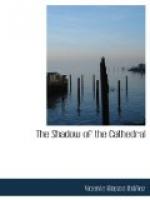[Footnote 1: Adelantamiento—Advancement.]
Don Gil de Albornoz, the famous cardinal, went to Italy, flying from Don Pedro the Cruel, and, like a great captain, reconquered all the territory of the Popes, who had taken refuge in Avignon. Don Gutierre III. went with Don Juan II. to fight against the Moors. Don Alfonso de Acuna fought in the civil war during the reign of Enrique IV.; and as a fitting end to this series of political and conquering prelates, rich and powerful as true princes, there arose the Cardinal Mendoza, who fought at the battle of Toro, and at the conquest of Granada, afterwards governing that kingdom; and Jimenez de Cisneros, who, finding no Moors left in the Peninsula to fight, crossed the sea and went to Oran, waving his cross and turning it into a weapon of war.
The seminarist admired these men, magnified by the mists of ancient history and the praises of the Church. For him they were the greatest men in the world after the Popes, and, indeed, often far superior to them. He was astonished that the Spaniards of the present times were so blind that they did not entrust their direction and government to the archbishops of Toledo, who in former centuries had performed such heroic deeds. The glory and advancement of the country was so intimately connected with their history, their dynasty was quite as great as that of the kings, and on more than one occasion they had saved these latter by their counsels and energy.
After these eagles came the birds of prey; after the prelates with their iron morions and their coats-of-mail came the rich and luxurious prelates, who cared for no other combats but those of the law courts, and were in perpetual litigation with towns, guilds, and private individuals in order to retain the possessions and the vast fortune accumulated by their predecessors.
Those who were generous like Tavera built palaces, and encouraged artists like El Greco, Berruguete and others, creating a Renaissance in Toledo, an echo from Italy. Those who were miserly, like Quiroga, reduced the expenses of the pompous church, to turn themselves into money-lenders to the kings, giving millions of ducats to those Austrian monarchs on whose dominions the sun never set, but who, nevertheless, found themselves obliged to beg almost as soon as their galleons returned from their voyages to America.
The Cathedral was the work of these priestly ecclesiastics; each one had done something in it which revealed his character. The rougher and more warlike its framework, that mountain of stone and wood which formed its skeleton; those who were more cultivated, elevated to the See in times of greater refinement, contributed the minutely-worked iron railings, the doors of lace-like stonework, the pictures, and the jewels which made its sacristy a veritable treasure house. The gestation of the giantess had lasted for three centuries; it seemed like those enormous prehistoric animals who slept so long in their mother’s womb before seeing the light.




